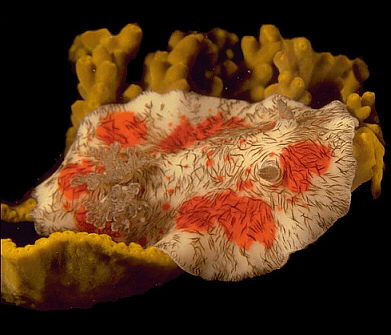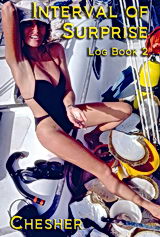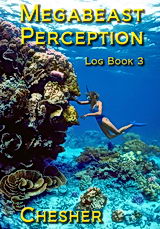Animation, Gaia and Smokey the Bear
I duck out from under the awning just as the sun crests the eastern rim of the volcano wall. Moira is still tucked up behind the earth berm of the Ark Park, webbed in with ropes between the derelict yachts that live here. We are now well into hurricane season. While the harbor is small and well protected, it is also filled with all those derelict tuna boats. If one came loose in a storm it could sink a yacht in an instant. Here, behind the protection of the rock and dirt wharf, we are reasonably safe.
I pull the Avon ashore, ducking under the oil and filth laden lines, and march briskly down the grimy path, past the dilapidated shower cubicle the yachties have built, and straight up to the chain-link fence outside the Harbor Master's house.
"Good morning, Richard," Says the Harbormaster from his back porch.
"Morning, John, looks like another scorcher. How's Dorothy today?" I put down my camera tripod and mount the Olympus.
"Oh, not bad. She's gettin up now. Still at it?" John Reed is from Tahiti. He and Captain Freddy hit it off from the start, speaking French together.
I check the alignment of the camera, the tripod locating spots, and the small black dot on the trunk of the papaya tree. I decide it looks OK, set the strobes, and take the shot. The papaya is now a nice, green globe about the size of a tennis ball. I started the time-lapse sequence when it was just a tiny flower bud.
John watches all this, gives a slight shake of his head, and goes back inside.
At Dave Irving's back door I stop and take my morning shot of the bananas. The bananas are turning out to be a nice, big bunch. I can't wait to get all the shots together and put onto film. I can visualize it in my mind's eye. The flower stalk shooting up from the plant, turning over, blossoming, the petals falling revealing the tiny banana flowers, the small bananas forming, swelling in little hands, filling out, getting bigger and bigger, then turning yellow and flashing into a hundred little Samoan faces.
"Good morning," Says Dave. He's standing in the doorway watching me, no doubt alerted by the strobe.
"Hi, Dave, how's Pidge today?"
"Sleeping. Pretty tired, you know."
Pidge is back from Hawaii after her latest round of chemotherapy treatments. The prognosis isn't good. And to make matters worse, she's drinking heavily. Dave looks tired and sad. "The bananas are looking good," I say lamely.
"Everything working out OK at the studio?" Dave helped talk the KVZK management into letting me use the old studio storage area to do my time-lapse filming. I have, for the past three months, been working there putting my 35-mm slides onto 16-mm film using the old Kodak camera Walter loaned me.
"Another few weeks and I'll be done," I hope. He nods and wanders back inside.
"Oh," Dave pops back out again, "Bill Travis is back in town. He'll be here this afternoon if you'd like to stop by."
"Great, thanks, Dave. See you then." I pick up my camera gear and head off to the studio, walking quickly in the still relatively cool morning air. I stride past the piles of garbage which line the waterfront, across the filth-cluttered native vegetable market, over a small bridge (glancing down at a layer of old cans and trash at least three feet deep), past the ancient wood court house, the nifty Fono buildings where the government meets, the post office building which could have been transplanted from Smallville, Iowa, and out the long path to the Rainmaker Hotel and the KVZK-TV studio.
The newscaster, an attractive Samoan girl, smiles and says hi as I bundle through the door into the ice-cold studio. I breeze past the technical workshop and pop open the studio doors with my hip. The huge, hollow room is cluttered with ghosts of 1" studio video gear left over from when the facility moved over to 3/4" U-matic. Enormous stuff. Who knows why they keep it. There are also bits and pieces of stage sets, lights and what not from the time when the studio produced lots of educational stuff. The station was originally intended to be the latest word in education-TV. On the second floor, the Department of Education designed TV-curricula. TV teachers then turned these lessons into 1" videotape. The tapes were broadcast to all the schools on the island on three channels, giving all the American Samoan children the best teachers with the best material for the least cost. Ho ho ho.
Now they have given up all that. They import broadcast tapes from Hawaii and they have three channels of everyday American TV programming. Phil and Penni seem to be the guys who run the place. My home-made animation stand is set up on a coil of cable and a wooden podium turned on its side. I load a new roll of 16-mm film into the antique Kodak camera, set the tray of selected slides in the carousel projector borrowed from DOE, and without further delay, switch it on. The image of a bright red nudibranch flashes onto the rear-view screen. I check my notebook. This is the part about evolution,
Our Constant Change in Relative Position

creates error in expected cycles.
The nudibranch will be animated with different shots showing it moving over a leaf coral. The unexpected is when it falls off, finds itself floating in Sea. I advance the slides to the shots of the nudibranch with a black background. I need to make a black paper mask to cut off some of the planktonic background in the black shots. I want it to seem like the animal has nothing at all around it - no sensory input - unexpected happens, memory fails. The music beats right here, I need to shoot five frames of each position and then shift the nudibranch 4 millimeters and shoot five more.
Somebody knocks at the studio door. I switch off the projector and go over to open it. Two men, improbably outfitted in real suits, stand there looking at me. "My name is Jim Swan," says the one with the Pat Boone smile. I work with the Foundation for the Human Environment and we're here doing a study on environmental awareness for the American Samoan Government. I understand you're working on environmental awareness, too."
"Uh, right. Come in, pull up a crate." They come in uncertainly, looking around at the mess. "A study on environmental awareness?"
"Yes, we're trying to assemble a plan for environmental awareness and so we're finding out who is doing what in this area. Rick Davis told us you were making an environmental awareness film."
"That's right. I've also been getting together some video clips and TV station breaks on environmental awareness. You don't mind if I keep on working while we talk? Who are you doing the study for?"
"The American Samoan Office of the Environmental Protection Agency. Our idea is to set up an organization, maybe a club, and invent a special character - like Smokey the Bear - to represent the caretaker of the environment. What would you think of that approach?"
"Frankly, not much. First of all, it lacks any semblance of Samoan culture. It's just not the way things are done here. And Polynesians never were much on inventing fictitious characters like Smokey the Bear.
"My own approach puts the responsibility on each individual. Have you ever read Raymond Firth? We the Tikopea? No? Well, he's an anthropologist who did a lot of work on the island of Tikopea in the Solomons. Cultural stuff. The important part of his work was embedded in the title of his book, 'We the Tikopea.' That was the islanders own expression for their island. They saw themselves as part of a living island, not as separate from it.
"I think that's what we need to concentrate on. Making the people realize they are, every single one of them, a part of a living island. Not in some Walt Disney sense, but in a realistic understanding of the fact the atoms of the soil, the water and the air are re-arranged into the patterns of behavior which are the people, the food plants and animals, the roads and buildings and the whole cultural scene.
"If the people of Tutuila could be made to understand that they ARE the living island, the consciousness of the living island, then environmental care becomes keeping the ultimate social unit - the life system of the whole island - healthy. One of my slide shows is called, `A healthy island is a happy island.'"
Jim and his friend look bewildered. He's still wearing his smile but there does not seem to be anyone looking out of his eyes. Oh well.
"Tie in the plants with social ideas. One video clip I produced says, 'When you plant flowers, you're planting beauty. When you harvest flowers, you harvest love.' It shows beautiful flowers. The aim is to get people thinking of plants and animals as part of themselves. Part of their life. Part of a living island."
"Is this like Lovelock's Gaia Hypothesis?" says Jim's friend. "The Earth is a Living Organism?"
"Yes. Lovelock's Gaia concept is built around the idea that the collective life of Earth alters the chemical composition of the planet's atmosphere and, in doing so, makes the planet ideally suited for life. This is also completely true for the chemical composition of the sea, for the creation and maintenance of fresh water ecosystems and for the soil. But other scientists tend to think of the Gaia hypothesis as trivial or, at best, a quaint idea. It's not a new idea, either. Stringer, also a British atmospheric scientist, wrote an excellent book about it. Guy Murchie writes about it, too, in his book The Seven Mysteries of Life. In the late 20's the superorganism concept was a fad for entomologists who wanted to explain hive activity in termites. But the proponents have tended to be squashed by two things. First, their books tend to be given stupid titles. Mysteries of Life, Secrets of Gods, and now Lovelock's greek goddess Gaia. This confuses the issue and frightens off many of the stuffier scientists.
"Second is the 'hypothesis' attitude. What we are talking about is not a hypothesis at all, but an observation. A viewpoint, really. The word hypo-thesis means below the level of a theory - an unproven concept, a working guess. There is no question about the fact that the island of Tutuila is a living system. Or that the planet Earth is a living system. What is in question is the logic system which enables us to think constructively about collective behavioral networks." I finish working on the camera set up and take three consecutive shots of the nudibranch. Jim is standing there in the glow of the projector, watching quietly with a kind of numb attention which means I've pushed their 'off' buttons.
"Anyway, the Gaia approach lacks a personal linkage with individual responsibility. It makes people seem almost insignificant. Lovelock tells us a mass of different kinds of bacteria ran the global homeostatic life system for more than a billion years and still are running the place. He's right about the evolution of life and the evolution of the physical environment being a single, indivisible process. But he's given the whole system into the domain of chemical feedback loops instead of focusing on the critical role played by the development of awareness. Here is the ghost in his machine. The thread of awareness in chaos is the directing force behind his foxes and rabbits and daises. Individual behavior is at the base of the pyramided layers of communal behavior. This is the critical element. It leads us to the inescapable conclusion that hominids are - along with their whole life system of plants and animals and buildings and roads - the defacto consciousness of the planet. What we do matters and matters more every day."
"This is in line with many of the American Indian beliefs," says Jim. "I've worked with American Indians for many years."
"Right, sure. Some of the American Indians had the right idea. So did the Polynesians, but both of them lost the thread a long time ago." I've lined up the last of the nudibranch shots and now I shoot the frames on the 16-mm camera. I thread my way through the cluttered studio and turn on the overhead lights.
"That's all really beside the point. Environmental action does have to have a sympathy with the natural world, but it seems the world isn't ready for heavy duty self-analysis yet. Samoans are not as environmentally unaware as many people think. Sure, the trash is piled high in the streets of Pago Pago, but once you get out into the villages, you'll see they are pretty clean and orderly. The places where the system is breaking down is where it interfaces with the American behavioral overlay. Our job is to find ways of telling people what to do to improve the environment. Not in a theoretical way, but definite actions individuals need to take to make the island a better place to live."
"Planting flowers, harvesting love?" Jim makes a note in his little book.
"Without a doubt. See, the messages drive the community awareness system. If there are no messages, the system does not function as a community. Television is a great way to get messages out into the community but most of what is signaled with modern TV programming isn't very constructive." I begin to feel this is taking too much time and pick up my notebook.
Jim picks up the cue and stands, "OK, thanks very much for your time. We'll keep in touch."
"Just out of curiosity, how much is your project costing?" I ask as they head for the door.
"Uh, not much, it's a small contract, really. I think something like 12 or 16 thousand dollars." He starts to say something more but then turns and leaves. Not much. Twelve or sixteen thousand dollars. I look around the storage room and stare at the crude animation rig and the ancient Kodak camera. Smokey the goddamned bear.



